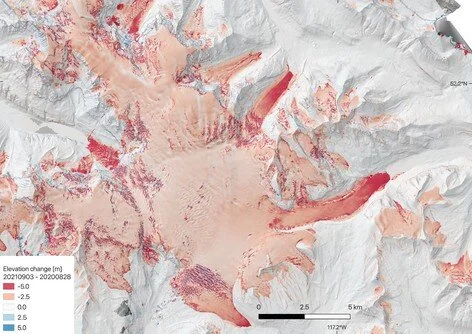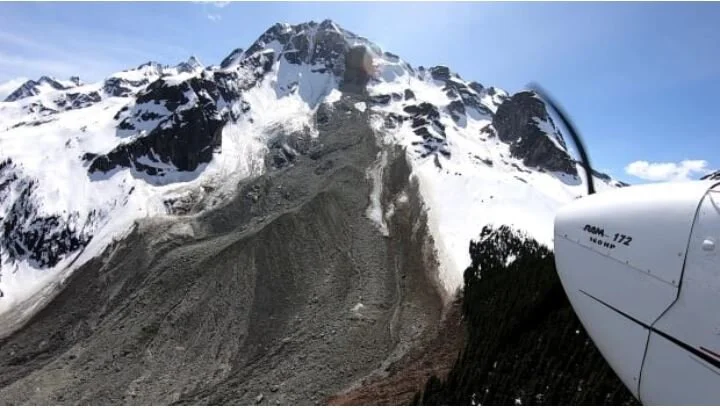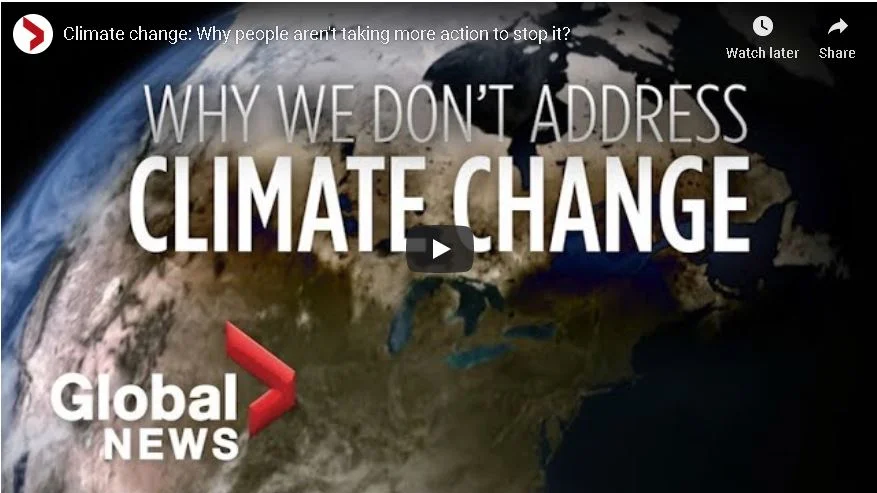If you drive the Icefields Parkway through the Canadian Rockies, you'll pass multiple turquoise-coloured lakes that are popular with tourists for taking photos. The lakes get their iconic colour from rock flour, which is similar in appearance to baker's flour used for making bread. Rock flour is made from glaciers grinding rocks into powder, which can take thousands of years.
Disappearing glaciers in B.C. put tourism, watersheds at risk: scientist
An estimated 80 per cent of B.C.’s glaciers are forecast to completely disappear and the impacts will trickle well beyond less beautiful vistas for British Columbians to look at. But any action to fight climate change can nonetheless help save glaciers in B.C.’s northern coastal mountains, one expert says. Brian Menounos, professor of geography at the University of Northern British Columbia and a Canada Research Chair in Glacier Change, recently co-authored a study in publication Science, with research suggesting implications for tourism, watersheds and public safety.
Most of Western Canada's glaciers will melt in 80 years, University of Northern B.C. study finds
A study by international researchers using a supercomputer at the University of Northern British Columbia (UNBC) has found that most of Western Canada's glaciers will disappear by the year 2100. The study, "Global Glacier Change in the 21st Century: Every Increase in Temperature Matters" was published Thursday in the journal Science. "A child born today will witness the near-complete disappearance of one of western Canada's most iconic symbols glaciers," reads a statement from the university.
Q+A: U of S water expert delivers talks to COP27 climate conference
John Pomeroy, director of the Global Water Futures program at the University of Saskatchewan is delivering virtual talks on glacier preservation and water issues in the circumpolar North to delegates at the COP27 climate summit. He spoke with Postmedia ahead of his second lecture, set to be delivered Wednesday. Q: What are some key points from your talks? A: Warming is proceeding faster in the mountains than other parts of the world. Glaciers are retreating, snowpacks are melting earlier in the year. We’re also getting extremely high temperatures, such as in 2021, and massive forest fires in areas as well as flash-flooding coming form heavy rainfall at times. All these are occurring at once, which is making it very challenging.
Iconic glaciers of Kilimanjaro, Yellowstone to disappear by 2050 due to global warming: UN
Some of the world's most famous glaciers, including in the Dolomites in Italy, the Yosemite and Yellowstone parks in the United States, and Mount Kilimanjaro in Tanzania are set to disappear by 2050 due to global warming — whatever the temperature rise scenario, according to a UNESCO report. UNESCO, the United Nations cultural agency, monitors some 18,600 glaciers across 50 of its World Heritage sites and said that glaciers in one-third of World Heritage sites will disappear by 2050 regardless of the applied climate scenario.
State of glaciers in the Canadian Rockies is 'dire right now,' expert warns
A Canadian professor is warning many of the iconic glaciers in the Canadian Rockies will be gone in the coming decades due to climate change. John Pomeroy is the Canada research chair in water resources and climate change at the University of Saskatchewan. He says the state of the glaciers in the Canadian Rockies is "dire right now." "We've lost hundreds of them already, just over the last few decades, and we'll be losing most of the rest over this century - including over most peoples' lifetimes."
BREAKING THE ICE
A drive through the Canadian Rockies will treat you to views of blue mountain lakes, wildlife and, of course, glaciers. But with our changing climate and warming winters, glaciers are receding at an alarming rate in Canada and around the world. Globally that will impact sea levels while here on the Prairies, the loss of our Rocky Mountain glaciers will affect our freshwater supply. “We’re past the tipping point for the glaciers in the Canadian Rockies,” says John Pomeroy, professor and Canada Research Chair in water resources and climate change at the University of Saskatchewan.
Researchers heading north to study glaciers in N.W.T., Nunavut
Nestled between jagged mountain peaks in Nahanni National Park Reserve, N.W.T., the Bologna Glacier stores water and serves as a smooth transportation corridor for animals like caribou, porcupines and wolverines. But, like ice all over the world, it's melting and shrinking in the warming climate, leaving the future uncertain for creatures that travel across it and ecosystems that exist below it — including the South Nahanni River, to which its melt water flows.
'Bad year for the glaciers': Climate change threatens glacier behind Edmonton's water source
The province is long past the oppressive “heat dome” that caused cities to swelter last summer, but warmer temperatures this year had a lasting effect on the glacier that feeds Edmonton’s water supply. The Saskatchewan Glacier terminus saw 10 metres of thinning this year, said Brian Menounos, an earth sciences professor at the University of Northern British Columbia and Canada Research Chair in glacier change. It’s also the glacier that feeds the North Saskatchewan River, Edmonton’s sole source of drinking water.
Do depressions in Canadian prairies hold the key to groundwater recharge?
The water cycle is a delicate balance. In natural settings, water from rainfall or snowmelt can soak into soil or runoff to streams. Some of the water is stored in natural underground reservoirs—called groundwater. Plants use up the water to grow, and then new precipitation refills the groundwater—a process called groundwater recharge. In dry climates, plants use up most of the water that enters the soil. So how does the groundwater get refilled? For Canadian prairies the answer is found in depressions located in the landscape. In these depressions, runoff from the surrounding land accumulates and moves into the groundwater.
Fresh water–our greatest asset
From the beginning of time on earth fresh water supply has been humanity’s main concern. Fresh water is the key to humankind’s prosperity or poverty, comfort or misery. Without fresh water there would be no life on earth. While water covers three-quarters of the earth’s surface, it cannot always be found where it is most needed, when it is needed and in the amounts that are required.
Newly discovered glaciers on Mars may help humans settle on the Red Planet one day
If humans are to truly become interplanetary settlers, we're going to need to have access to water — a lot of it. But loading it on a rocket would be heavy, and trying to escape Earth's gravity with all that weight would be costly. Satellite observations by orbiters around Mars suggest there is an ice sheet in a flat plain called Arcadia Planitia at roughly 35 degrees north latitude. It's a site that both NASA and SpaceX are considering for future human exploration. In this new study, researchers found that it's not just an ice sheet, but a kind of shallow river of ice, similar to what we see in regions of Antarctica.
Arctic Ocean was once a tub of fresh water covered with a half-mile of ice
The Arctic Ocean was once a pool of fresh water capped with an ice shelf half as thick as the Grand Canyon is deep. If that's hard to envision, don't despair. Scientists were surprised at the discovery, published Wednesday (Feb. 3) in the journal Nature, as well. The trick to envisioning this odd arrangement is to think about the relationship between ice sheets and the ocean. When ice sheets melt, they dump water into the ocean, raising the sea level. But when ice sheets grow, as they have during Earth's glacial periods, sea level drops.
Earth's frozen 'water towers' threatened by warming, population growth, report says
Water frozen at the tops of mountains that helps sustain up to a quarter of the human population is under threat from climate change, population growth and lack of proper management, according to a new international study. The systems store and transport water through glaciers, snow packs, lakes and streams. They supply water to 1.9 billion people on Earth. A group of 32 international scientists — including one Canadian — published a paper in the journal Nature on Monday to highlight the importance and vulnerabilities of what they call Earth's 78 water towers.
Water shortages and yearly floods: Canada won’t escape climate crisis, UN report says
Damage to Earth’s oceans and glaciers from climate change is outpacing the ability of governments to protect them, a new report from an international scientific panel concludes. “The capacity of governance systems in polar and ocean regions to respond to climate change impacts has strengthened recently,” says the Intergovernmental Panel on Climate Change. “But this development is not sufficiently rapid or robust to adequately address the scale of increasing projected risks.”
















